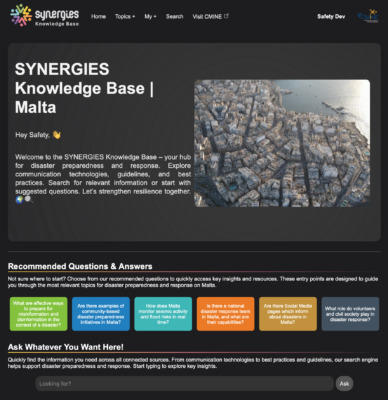
Towards a Shared Understanding of Crisis Communication
Effective communication is a cornerstone of disaster preparedness. Within the Horizon-Europe project SYNERGIES, the safety innovation center is developing the SYNERGIES Knowledge Base for Innovative Channels and Communication (KB4ICC) — a modular, user-driven and web-based platform to share guidelines, technologies and practice examples for effective crisis communication. It aims to bridge the gap between research, technology, and real-world practice by focusing on innovative approaches such as social media and crowdsourcing, influencers, mis- and disinformation and early warnings. To enable intuitive and tailored access to relevant content, the KB4ICC is equipped with a semantic search engine. This semantic search provides contextualized information based on the requests of the users.
Evaluated by Users Across Europe
From the initial stages of development, the KB4ICC has been co-created in close collaboration with its intended stakeholders. To ensure that the knowledge base meets real-world needs, it has at this stage in Month 19 been tested in three dedicated evaluation workshops involving local practitioners, public authorities and NGOs from La Réunion, Rotterdam and Malta plus a continuous involvement of international Advisory Board members. These activities were a core part of our co-creation approach, providing an opportunity for direct, experience-based feedback and open discussion.
Participants evaluated the KB4ICC’s usability, the structure of its content, and its applicability in real life. Their input is instrumental in identifying the strengths, such as its structure and the relevance of its solutions, as well as areas for improvement, including navigation, visual presentation and accessibility for non-expert users. The workshops also confirmed our anticipation of growing demand for a centralised, practical resource that makes innovative communication strategies discoverable and actionable.
Three modules, many perspectives
To make the knowledge base accessible and applicable across different contexts, the KB4ICC is structured into three interconnected modules. Each module captures a specific dimension of crisis communication thematics and is continuously refined based on user input:
- The Innovative Methods Module presents new and emerging communication approaches. It includes for example guidelines and practical recommendations for using social media, implementing crowdsourcing initiatives, and addressing the challenges of misinformation and disinformation. This module supports users in identifying the most effective communication processes for their target audiences and contexts.
- The Software Technologies Module provides an overview of relevant technologies and tools that support digital crisis communication. This includes early warning systems, participatory tools, and digital interfaces designed to enhance both internal coordination and communication with the public. The module helps users understand where and how specific tools can be applied.
- The Lessons Identified Module collects good and bad practices from real-world emergencies, exercises, and previous disaster risk reduction projects. It offers reflections on what worked, what didn’t, and why—providing users with valuable insights for improving their own strategies.
Building on results of previous projects
The KB4ICC is actively integrating previous projects, the so-called component projects. Relevant insights and resources – for example from the H2020 project LINKS has been taken up and adjusted to fit the KB4ICC’s structure and user needs. The core products of LINKS are captured within the LINKS Community Center which is developed and hosted by the safety innovation center. The approach to build upon existing results and involve the responsible partners allows to align with established knowledge. In addition, an integration to the well positioned Crisis Management Innovation Network Europe (CMINE), established out of the FP7 project DRIVER+, is implemented to support transferability and sustainability. By linking the KB4ICC with past and ongoing initiatives, we aim to strengthen synergies across the disaster resilience community for a better and more resilient future.
Next Steps: Evolving with Practice
While the KB4ICC is in the development phase, the early stages have shown the value of an iterative, co-designed process of a web-based knowledge base able to provide tailored information. The feedback from the three evaluation workshops with La Reunion, Rotterdam and Malta continues to shape the result, helping us refine the content, improve user experience, and ensure accessibility across stakeholder groups. Beyond extending the current modules, we are also exploring ways to integrate new contributions, connected with other SYNERGIES components, and ensure long-term sustainability.
Conclusion
The KB4ICC is already demonstrating its potential as a practical, collaborative resource for strengthening disaster preparedness across Europe. As we move into the second half of the project, we are excited to further refine the knowledge base, expand its content, and enhance its usability. If you’re interested in learning more or exploring how the KB4ICC could support your work in crisis communication, we would be very happy to hear from you.

